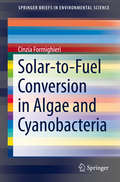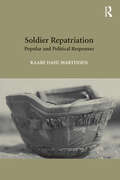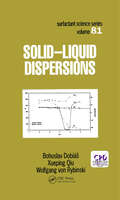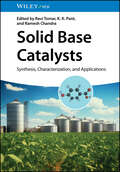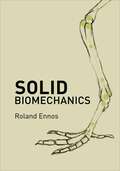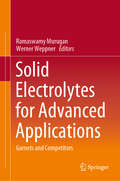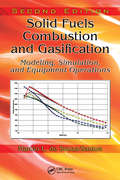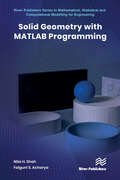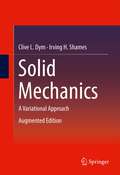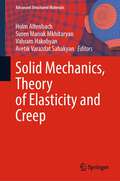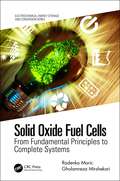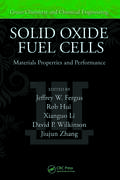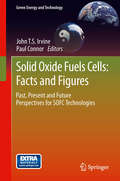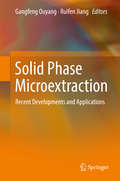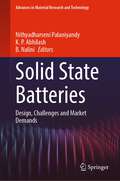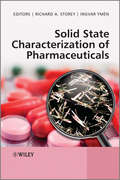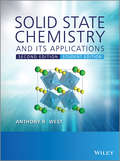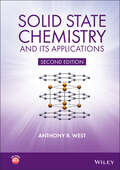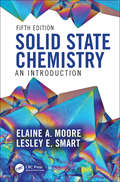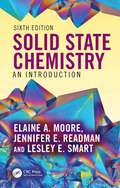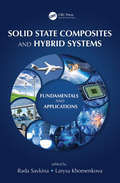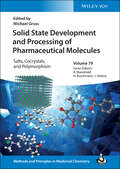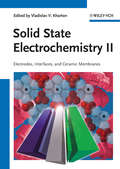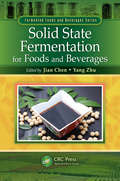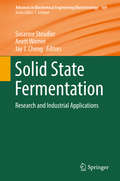- Table View
- List View
Solar-to-fuel conversion in algae and cyanobacteria
by Cinzia FormighieriThis volume is focused on solar-to-fuel conversion using algae and cyanobacteria for advanced generation biofuels. Production of biofuels needs to rely on cheap and renewable resources, in order to be economically viable and environmentally sustainable in the long term. Solar energy is an abundant and renewable resource, and strategies for solar-to-fuel conversion have the potential to sustain our energy demands in the long term and to be carbon-dioxide neutral. First generation biofuels are those already on the market, such as bio-ethanol from sugarcane and corn starch, biodiesel from oil seed crops. However, development of a single biofuel, as efficient as it may be, would be insufficient and could not sustain the global demand for energy. The next generation of advanced biofuels explores alternative feedstocks and technologies, finding novel solar-to-fuel solutions. Algae and cyanobacteria can convert sunlight into chemical energy through the process of photosynthesis. They represent an alternative with respect to crops for solar-to-fuel conversion that does not compete with food for arable land. This SpringerBrief focuses only on solar-to-fuel conversion for production of advanced biofuels, pointing to the importance of relying on the sun for our sustainability in the long term. It is the only current publication to discuss the problem of light-utilization inefficiency during mass cultivation of micro-algae. This review also addresses the potential of cyanobacteria for the generation of direct photosynthesis-to-fuel platforms and discusses both possibilities and constraints for future developments.
Soldier Repatriation: Popular and Political Responses
by Kaare Dahl MartinsenSoldier repatriation from Afghanistan has impacted debate about the war. This study highlights this impact with particular focus on Britain, Denmark and Germany. All three countries deployed soldiers soon after the 9/11 attacks, yet their role in Afghanistan and the casualty rates suffered, have been vastly different. This book looks at how their casualties influenced the framing of the war by analysing the political discourse about the casualties, how the media covered the repatriation and the burials, and how the dead were officially recognised and commemorated. Explaining how bodies count is not done exclusively by focusing on the political leadership and the media in the three countries, the response from the men and women in Afghanistan to the official framing of the war is given particular weight. Martinsen contributes to our understanding of European strategic culture by showing how countries respond to the same security challenges.
Solid - Liquid Dispersions (Surfactant Science)
by Bohuslav DobiášReviews a range of fundamental concepts, recent developments and practical applications in dispersion theory, along with relevant insights from colloidal and interfacial science. The text contains new work on the stabilization of solid-liquid dispersions. It focuses on topics as varied as electrostatics, hydrodynamics and rheology.
Solid Base Catalysts: Synthesis, Characterization, and Applications
by Ramesh Chandra K. K. Pant Ravi TomarFoundational knowledge and practical approaches of an interesting catalyst class for greener and cleaner chemical synthesis Solid Base Catalysts provides insights and information on cutting-edge heterogeneous catalysis technologies and approaches of non-corrosive and easy-to-use solid catalysts that can replace conventional liquid catalysts that are known to pose operational problems. Edited by three highly qualified authors with contributions from experts in industry and academia, Solid Base Catalysts includes: Latest and most advanced studies in the characterization of solid catalysts, with applications in various organic transformationsVersatile reaction types where solid catalysts can be used as well as the multidisciplinary nature of solid base catalyst research and its connections to other fieldsMulticomponent reactions for eco-compatible heterocyclic synthesis over solid catalysts and synthesis routes, experimental protocols, and other considerations for optimizing catalyst propertiesAdvanced methodologies and applications for analyzing solid catalysts and challenges and future prospects in the field Solid Base Catalysts is a complete reference on the subject for researchers and professionals in materials science, green chemistry, surface chemistry, and chemical engineering.
Solid Biomechanics
by Roland EnnosSolid Biomechanics is the first book to comprehensively review the mechanical design of organisms. With a physical approach and a minimum of mathematics, the textbook introduces readers to the world of structural mechanics and sheds light on the dazzling array of mechanical adaptations that link creatures as dissimilar as bacteria, plants, and animals. Exploring a wide range of subjects in depth, from spider silks and sharkskin to climbing plants and human food processing, this immensely accessible text demonstrates that the bodies of animals and plants are masterpieces of engineering, enabling them to survive in a hostile world. The textbook describes how organisms construct materials from limited components, arrange materials into efficient structures that withstand different types of stresses, and interact mechanically with their environment. Looking at practical and historical aspects of the subject, the book delves into how the mechanics of organisms might be applied to other engineering scenarios and considers the ways structural biomechanics could and should develop in the future if more is to be learned about the form and function of organisms. Solid Biomechanics will be useful to all those interested in how organisms work, from biologists and engineers to physicists and students of biomechanics, bionics, and materials science. The first comprehensive review of the structural mechanics of organisms Introduces the subject using a physical approach involving minimal mathematics Three complementary sections: materials, structures, and mechanical interactions of organisms Links the dazzling array of mechanical adaptations seen in widely differing organisms Practical and historical approach shows how mechanical adaptations have been discovered and how readers can perform their own investigations
Solid Electrolytes for Advanced Applications: Garnets and Competitors
by Ramaswamy Murugan Werner WeppnerThis book highlights the state of the art in solid electrolytes, with particular emphasis on lithium garnets, electrolyte-electrode interfaces and all-solid-state batteries based on lithium garnets. Written by an international group of renowned experts, the book addresses how garnet-type solid electrolytes are contributing to the development of safe high energy density Li batteries. Unlike the flammable organic liquid electrolyte used in existing rechargeable Li batteries, garnet-type solid electrolytes are intrinsically chemically stable in contact with metallic lithium and potential positive electrodes, while offering reasonable Li conductivity. The book's respective chapters cover a broad spectrum of topics related to solid electrolytes, including interfacial engineering to resolve the electrolyte-electrode interfaces, the latest developments in the processing of thin and ultrathin lithium garnet membranes, and fabrication strategies for the high-performance solid-state batteries.This highly informative and intriguing book will appeal to postgraduate students and researchers at academic and industrial laboratories with an interest in the advancement of high energy-density lithium metal batteries
Solid Fuels Combustion and Gasification: Modeling, Simulation, and Equipment Operations Second Edition (Mechanical Engineering)
by Marcio L. de Souza-SantosAs an increasing number of professionals and graduate students enter the field of solid-based power generation, they all require an command of process and equipment, as well as the theory behind it all. However, their informational needs and understanding differ based on their experience and the task at hand.Solid Fuels Combustion and Gasification:
Solid Geometry with MATLAB Programming (River Publishers Series in Mathematical and Engineering Sciences)
by Nita H. Shah Falguni S. AcharyaSolid geometry is defined as the study of the geometry of three-dimensional solid figures in Euclidean space. There are numerous techniques in solid geometry, mainly analytic geometry and methods using vectors, since they use linear equations and matrix algebra. Solid geometry is quite useful in everyday life, for example, to design different signs and symbols such as octagon shape stop signs, to indicate traffic rules, to design different 3D objects like cubicles in gaming zones, innovative lifts, creative 3D interiors, and to design 3D computer graphics. Studying solid geometry helps students to improve visualization and increase logical thinking and creativity since it is applicable everywhere in day-to-day life. It builds up a foundation for advanced levels of mathematical studies. Numerous competitive exams include solid geometry since its foundation is required to study other branches like civil engineering, mechanical engineering, computer science engineering, architecture, etc. This book is designed especially for students of all levels, and can serve as a fundamental resource for advanced level studies not only in mathematics but also in various fields like engineering, interior design, architecture, etc. It includes theoretical aspects as well as numerous solved examples. The book includes numerical problems and problems of construction as well as practical problems as an application of the respective topic. A special feature of this book is that it includes solved examples using the mathematical tool MATLAB.
Solid Mechanics
by Clive L. Dym Irving H. ShamesSolid Mechanics: A Variational Approach, Augmented Edition presents a lucid and thoroughly developed approach to solid mechanics for students engaged in the study of elastic structures not seen in other texts currently on the market. This work offers a clear and carefully prepared exposition of variational techniques as they are applied to solid mechanics. Unlike other books in this field, Dym and Shames treat all the necessary theory needed for the study of solid mechanics and include extensive applications. Of particular note is the variational approach used in developing consistent structural theories and in obtaining exact and approximate solutions for many problems. Based on both semester and year-long courses taught to undergraduate seniors and graduate students, this text is geared for programs in aeronautical, civil, and mechanical engineering, and in engineering science. The authors' objective is two-fold: first, to introduce the student to the theory of structures (one- and two-dimensional) as developed from the three-dimensional theory of elasticity; and second, to introduce the student to the strength and utility of variational principles and methods, including briefly making the connection to finite element methods. A complete set of homework problems is included.
Solid Mechanics, Theory of Elasticity and Creep (Advanced Structured Materials #185)
by Holm Altenbach Suren Manuk Mkhitaryan Vahram Hakobyan Avetik Varazdat SahakyanThis book presents fundamental theoretical and experimental studies of well-known scientists in solid mechanics, hydromechanics, aeromechanics, biomechanics, etc. These studies relate to contact and mixed problems of the theory of elasticity and viscoelasticity, tribology, fracture mechanics, electroelasticity, magnetoelasticity, as well as to the theory of anisotropic shells and plates and are aimed at application in various areas of engineering practice. The book is devoted to the 110th birthday of academician N.Kh. Arutunyan.
Solid Oxide Fuel Cells: From Fundamental Principles to Complete Systems
by Radenka MaricSolid Oxide Fuel Cells: From Fundamental Principles to Complete Systems is as a valuable resource for beginners, experienced researchers, and developers of solid oxide fuel cells. It provides a fundamental understanding of SOFCs by covering the present state-of-the-art as well as ongoing research and future challenges to be solved. It discusses current and future materials and provides an overview of development activities with a more general system approach toward fuel cell plant technology, including plant design and economics, industrial data and advances in technology. Provides an understanding of the operating principles of SOFCs Discusses state-of-the-art materials, technologies and processes Includes a review of current industry and lessons learned Offers a more general system approach toward fuel cell plant technology, including plant design and economics of SOFC manufacture Covers significant technical challenges that remain to be solved Presents the status of government activities, industry and market This book is aimed at electrochemists, batteries and fuel cell engineers, alternative energy scientists, and professionals in materials science.
Solid Oxide Fuel Cells: Materials Properties and Performance
by Jiujun Zhang Jeffrey W. Fergus Xianguo Li David P. Wilkinson Rob HuiThe First Book Centered on Materials Issues of SOFCsAlthough the high operating temperature of solid oxide fuel cells (SOFCs) creates opportunities for using a variety of fuels, including low-grade hydrogen and those derived from biomass, it also produces difficulties in materials performance and often leads to materials degradation during operatio
Solid Oxide Fuels Cells: Facts and Figures
by John T.S. Irvine Paul ConnorSolid Oxide Fuel Cells (SOFCs) operate at high temperatures allowing more fuel flexibility and also useful heat output and so increase total efficiency, but does give some interesting engineering challenges. Solid Oxide Fuels Cells: Facts and Figures provides clear and accurate data for a selection of SOFC topics from the specific details of Ni cermet anodes, chemical expansion in materials, and the measuring and modelling of mechanical stresses, to the broader scope of the history and present design of cells, to SOFC systems and the future of SOFC. Celebrating Ulf Bossel's work on Solid Oxide Fuel Cells, and especially his running of the European Fuel Cell Forum, Solid Oxide Fuels Cells: Facts and Figures covers important topics on the way including intermediate temperature fuel cells, metal supported fuel cells and both new materials and engineering solutions to some of the challenges of getting SOFC to market. The chapters are based on the special plenary talks given by some of the most respected and talented people in the field at the 2010 European SOFC Forum in Luzern and the title for this book comes from the report produced by Ulf for the IEA "Final Report on SOFC Data, Facts and Figures", Swiss Federal Office of Energy, Berne, 1992. The comprehensive nature of Solid Oxide Fuels Cells: Facts and Figures makes it a key resource of SOFC topics for students, lecturers, researchers and industry practitioners alike.
Solid Phase Microextraction
by Gangfeng Ouyang Ruifen JiangThis book offers comprehensive information on the developments and applications of the solid phase microextraction (SPME) technique. The first part of the book briefly introduces readers to the fundamentals of SPME, while subsequent sections describe the applications of SPME technique in detail, including environmental analysis (air, water, soil/sediments), food analysis (volatile/nonvolatile compounds), and bioanalysis (plants, animal tissues, body fluids). The advantages and future challenges of the SPME technique are also discussed. Including recent research advances and further developments of SPME, the book offers a practical reference guide and a valuable resource for researchers and users of SPME techniques. The target audience includes analytical chemists, environmental scientists, biological scientists, material scientists, and analysts, as well as students at universities/institutes in related fields. Dr. Gangfeng Ouyang is a Professor at the School of Chemistry and Chemical Engineering, Sun Yat-sen University, China. Dr. Ruifen Jiang is an Associate Professor at the School of Environment, Jinan University, China.
Solid State Batteries: Design, Challenges and Market Demands (Advances in Material Research and Technology)
by B. Nalini Nithyadharseni Palaniyandy K. P. AbhilashThis book offers a comprehensive analysis of novel design strategies in higher energy solid-state lithium batteries. It describes synthesis and experimental techniques to characterize the physical, chemical and electrochemical properties of the electrode and electrolytes. The book reports on electrochemical measurements of conductivity and related parameters in solid electrolytes and its interfaces. It also presents various technologies that have been used for the fabrication of all-solid-state lithium-ion batteries such as thin-film, 3D printing (additive manufacturing) and atomic layer deposition. A large part of the text focus on the description on the complete functioning and challenges with the electrochemistry of the electrodes and solid electrolyte interfaces. The book also supplies valuable insight into potential growth opportunities in this exciting market and cost-effective design tactics in solid-state assemblies.
Solid State Characterization of Pharmaceuticals
by Ingvar Ymén Richard A. StoreyThe field of solid state characterization is central to the pharmaceutical industry, as drug products are, in an overwhelming number of cases, produced as solid materials. Selection of the optimum solid form is a critical aspect of the development of pharmaceutical compounds, due to their ability to exist in more than one form or crystal structure (polymorphism). These polymorphs exhibit different physical properties which can affect their biopharmaceutical properties.This book provides an up-to-date review of the current techniques used to characterize pharmaceutical solids. Ensuring balanced, practical coverage with industrial relevance, it covers a range of key applications in the field. The following topics are included: Physical properties and processesThermodynamicsIntellectual guidanceX-ray diffractionSpectroscopy MicroscopyParticle sizingMechanical propertiesVapour sorptionThermal analysis & CalorimetryPolymorph predictionForm selection
Solid State Chemistry and its Applications
by Anthony R. WestSolid State Chemistry and its Applications, 2nd Edition: Student Edition is an extensive update and sequel to the bestselling textbook Basic Solid State Chemistry, the classic text for undergraduate teaching in solid state chemistry worldwide.Solid state chemistry lies at the heart of many significant scientific advances from recent decades, including the discovery of high-temperature superconductors, new forms of carbon and countless other developments in the synthesis, characterisation and applications of inorganic materials. Looking forward, solid state chemistry will be crucial for the development of new functional materials in areas such as energy, catalysis and electronic materials.This revised edition of Basic Solid State Chemistry has been completely rewritten and expanded to present an up-to-date account of the essential topics and recent developments in this exciting field of inorganic chemistry. Each section commences with a gentle introduction, covering basic principles, progressing seamlessly to a more advanced level in order to present a comprehensive overview of the subject. This new Student Edition includes the following updates and new features:Expanded coverage of bonding in solids, including a new section on covalent bonding and more extensive treatment of metallic bonding.Synthetic methods are covered extensively and new topics include microwave synthesis, combinatorial synthesis, mechano-synthesis, atomic layer deposition and spray pyrolysis.Revised coverage of electrical, magnetic and optical properties, with additional material on semiconductors, giant and colossal magnetoresistance, multiferroics, LEDs, fibre optics and solar cells, lasers, graphene and quasicrystals.Extended chapters on crystal defects and characterisation techniques.Published in full colour to aid comprehension.Extensive coverage of crystal structures for important families of inorganic solids is complemented by access to CrystalMaker® visualization software, allowing readers to view and rotate over 100 crystal structures in three dimensions.Solutions to exercises and supplementary lecture material are available online.Solid State Chemistry and its Applications, 2nd Edition: Student Edition is a must-have textbook for any undergraduate or new research worker studying solid state chemistry.
Solid State Chemistry and its Applications
by Anthony R. WestSOLID STATE CHEMISTRY AND ITS APPLICATIONS A comprehensive treatment of solid state chemistry complete with supplementary material and full colour illustrations from a leading expert in the field. Solid State Chemistry and its Applications, Second Edition delivers an advanced version of West’s classic text in solid state chemistry, expanding on the undergraduate Student Edition to present a comprehensive treatment of solid state chemistry suitable for advanced students and researchers. The book provides the reader with an up-to-date account of essential topics in solid state chemistry and recent developments in this rapidly developing field of inorganic chemistry. Significant updates and new content in this second edition include: A more extensive overview of important families of inorganic solids including spinels, perovskites, pyrochlores, garnets, Ruddlesden-Popper phases and many more New methods to synthesise inorganic solids, including sol-gel methods, combustion synthesis, atomic layer deposition, spray pyrolysis and microwave techniques Advances in electron microscopy, X-ray and electron spectroscopies New developments in electrical properties of materials, including high Tc superconductivity, lithium batteries, solid oxide fuel cells and smart windows Recent developments in optical properties, including fibre optics, solar cells and transparent conducting oxides Advances in magnetic properties including magnetoresistance and multiferroic materials Homogeneous and heterogeneous ceramics, characterization using impedance spectroscopy Thermoelectric materials, MXenes, low dimensional structures, memristors and many other functional materials Expanded coverage of glass, including metallic and fluoride glasses, cement and concrete, geopolymers, refractories and structural ceramics Overview of binary oxides of all the elements, their structures, properties and applications Featuring full color illustrations throughout, readers will also benefit from online supplementary materials including access to CrystalMaker® software and over 100 interactive crystal structure models. Perfect for advanced students seeking a detailed treatment of solid state chemistry, this new edition of Solid State Chemistry and its Applications will also earn a place as a desk reference in the libraries of experienced researchers in chemistry, crystallography, physics, and materials science.
Solid State Chemistry: An Introduction
by Elaine A. Moore Lesley E. Smart"A comprehensive guide to solid-state chemistry which is ideal for all undergraduate levels. It covers well the fundamentals of the area, from basic structures to methods of analysis, but also introduces modern topics such as sustainability." Dr. Jennifer Readman, University of Central Lancashire, UK "The latest edition of Solid State Chemistry combines clear explanations with a broad range of topics to provide students with a firm grounding in the major theoretical and practical aspects of the chemistry of solids." Professor Robert Palgrave, University College London, UK Building a foundation with a thorough description of crystalline structures, this fifth edition of Solid State Chemistry: An Introduction presents a wide range of the synthetic and physical techniques used to prepare and characterise solids. Going beyond this, this largely nonmathematical introduction to solid-state chemistry includes the bonding and electronic, magnetic, electrical, and optical properties of solids. Solids of particular interest—porous solids, superconductors, and nanostructures—are included. Practical examples of applications and modern developments are given. It offers students the opportunity to apply their knowledge in real-life situations and will serve them well throughout their degree course. New in the Fifth Edition A new chapter on sustainability in solid-state chemistry written by an expert in this field Cryo-electron microscopy X-ray photoelectron spectroscopy (ESCA) Covalent organic frameworks Graphene oxide and bilayer graphene Elaine A. Moore studied chemistry as an undergraduate at Oxford University and then stayed on to complete a DPhil in theoretical chemistry with Peter Atkins. After a two-year postdoctoral position at the University of Southampton, she joined the Open University in 1975, becoming a lecturer in chemistry in 1977, senior lecturer in 1998, and reader in 2004. She retired in 2017 and currently has an honorary position at the Open University. She has produced OU teaching texts in chemistry for courses at levels 1, 2, and 3 and written texts in astronomy at level 2 and physics at level 3. She was team leader for the production and presentation of an Open University level 2 chemistry module delivered entirely online. She is a Fellow of the Royal Society of Chemistry and a Senior Fellow of the Higher Education Academy. She was co-chair for the successful Departmental submission of an Athena Swan bronze award. Lesley E. Smart studied chemistry at Southampton University, United Kingdom. After completing a PhD in Raman spectroscopy, she moved to a lectureship at the (then) Royal University of Malta. After returning to the United Kingdom, she took an SRC Fellowship to Bristol University to work on X-ray crystallography. From 1977 to 2009, she worked at the Open University chemistry department as a lecturer, senior lecturer, and Molecular Science Programme director, and she held an honorary senior lectureship there until her death in 2016. At the Open University, she was involved in the production of undergraduate courses in inorganic and physical chemistry and health sciences. She served on the Council of the Royal Society of Chemistry and as the chair of their Benevolent Fund.
Solid State Chemistry: An Introduction
by Elaine A. Moore Jennifer ReadmanSolid State Chemistry: An Introduction 6th Edition is a fully revised edition of one of our most successful textbooks with at least 20% new information and new images of crystal structures.Solid-state chemistry is still a rapidly advancing field, contributing to areas such as batteries for transport and energy storage, nanostructured materials and porous materials for the capture of carbon dioxide and other pollutants.This edition aims, as previously, not only to teach the basic science that underpins the subject but also to direct the reader to the most modern techniques and to expanding and new areas of research. The user-friendly style takes a largely non-mathematical approach and gives practical examples of applications of solid-state materials and concepts.The chapter on sustainability written by an expert in the field has been updated, and examples of the relevance of solid-state chemistry to sustainability are used throughout. The chapter on batteries has been extended to include fuel cells.Other new topics in this edition include X-ray-free electron laser crystallography and thermal properties of materials.A companion website offering accessible resources for students and instructors alike, featuring topics and tools such as quizzes, videos, web links and more has been provided for this edition.
Solid State Composites and Hybrid Systems: Fundamentals and Applications
by Rada Savkina Larysa KhomenkovaSolid state composites and hybrid systems offer multifunctional applications in various fields of human life, demonstrating solutions to the key problems of the environment, human health, biology, medicine, electronics, energy harvesting and storage. Exploring this innovative field of research, this book details the wide range of materials, techniques, and approaches utilised in composite and hybrid structures in recent years. It will be of interest not only for experienced researchers but also for postgraduate students and young researchers entering the fields of nanoscience, material sciences, and bioengineering. Features: Contains the latest research developments in the materials, techniques, patents, and approaches in the field Includes both fundamental aspects and applied research Edited by two highly experienced researchers
Solid State Development and Processing of Pharmaceutical Molecules: Salts, Cocrystals, and Polymorphism (Methods & Principles in Medicinal Chemistry)
by Raimund Mannhold Jörg Holenz Helmut BuschmannA guide to the latest industry principles for optimizing the production of solid state active pharmaceutical ingredients Solid State Development and Processing of Pharmaceutical Molecules is an authoritative guide that covers the entire pharmaceutical value chain. The authors—noted experts on the topic—examine the importance of the solid state form of chemical and biological drugs and review the development, production, quality control, formulation, and stability of medicines. The book explores the most recent trends in the digitization and automation of the pharmaceutical production processes that reflect the need for consistent high quality. It also includes information on relevant regulatory and intellectual property considerations. This resource is aimed at professionals in the pharmaceutical industry and offers an in-depth examination of the commercially relevant issues facing developers, producers and distributors of drug substances. This important book: Provides a guide for the effective development of solid drug forms Compares different characterization methods for solid state APIs Offers a resource for understanding efficient production methods for solid state forms of chemical and biological drugs Includes information on automation, process control, and machine learning as an integral part of the development and production workflows Covers in detail the regulatory and quality control aspects of drug development Written for medicinal chemists, pharmaceutical industry professionals, pharma engineers, solid state chemists, chemical engineers, Solid State Development and Processing of Pharmaceutical Molecules reviews information on the solid state of active pharmaceutical ingredients for their efficient development and production.
Solid State Electrochemistry II: Electrodes, Interfaces and Ceramic Membranes
by Vladislav V. KhartonThe ideal addition to the companion volume on fundamentals, methodologies, and applications, this second volume combines fundamental information with an overview of the role of ceramic membranes, electrodes and interfaces in this important, interdisciplinary and rapidly developing field. Written primarily for specialists working in solid state electrochemistry, this first comprehensive handbook on the topic focuses on the most important developments over the last decade, as well as the methodological and theoretical aspects and practical applications. This makes the contents equally of interest to material, physical and industrial scientists, and to physicists. Also available as a two-volume set.
Solid State Fermentation for Foods and Beverages (Fermented Foods and Beverages Series #2)
by Jian Chen Yang ZhuAlthough one of the oldest microbial technologies used in food processing, solid-state fermentation (SSF) had, until recently, fallen out of favor. However, based on a series of established mathematical models, new design concepts for SSF bioreactors and process control strategies have been proposed, allowing SSF technology to reach new levels. Sol
Solid State Fermentation: Research and Industrial Applications (Advances in Biochemical Engineering/Biotechnology #169)
by Susanne Steudler Anett Werner Jay J. ChengThis book reviews the wide range of products and applications of solid state fermentation as well as the development of this cultivation technology over the last years. In this book, readers will also learn about the challenges of solid state fermentation, including process management, reactor design, scale-up and the formation of process-specific products. Solid fermentation is a traditional cultivation technique of food technology and involves all cultivations of microorganisms on a solid substrate without free liquid phase. In the course of development of Biotechnology it was replaced by liquid cultivation mainly in the western countries. Over the past few years, solid-state fermentation is now becoming more important and has moved more back into focus. Especially, it is suitable for the cultivation of filamentous organisms, like ascomycetes and basidiomycetes, but also for various yeasts and bacteria. The products and applications of solid-state fermentation are as diverse as the microorganisms. They range from enzyme production to the production of antibiotics and pigments to the use in environmental technology and energy production.
